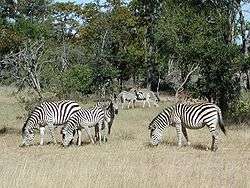Wildlife of Angola




The wildlife of Angola is composed of its flora and fauna.
In the Quiçama National Park in the Kwanza River Valley, Angola's top military brass are battling to reintroduce elephants, antelope and other species that once roamed the country's 10 national parks before the civil war. Quiçama spans nearly 10,000 km² about 75 kilometres south of Luanda, the country's capital. Backed by a privately funded, $10 million (U.S.) project, the generals are working with South African wildlife experts to revive Angola's wildlife, beginning with the Quiçama Park.
Angola's protracted war has had a catastrophic effect on the country's wildlife. Forty years ago, thousands of animals roamed the fertile bushland of Quiçama. But over the years, the animals fell prey to landmines, ivory-stalking poachers and hungry locals. Many animals were slaughtered by the country's military, which used low-flying helicopters to take pot shots at big game.
The civil war between the army and UNITA rebels began after a 14-year struggle for independence from Portugal, which was granted in 1975.The war cost the lives of more than a million people and drove 2.5 million more from their homes.
Fauna
Mammals
Birds
The avifauna of Angola includes a total of 983 species, of which 14 are endemic, 1 has been introduced by humans, and 4 are rare or accidental. 20 species are globally threatened.
The western Angola Endemic Bird Area has 14 range-restricted species. Little is known about the conservation status of the region's birds due to the civil war that has raged in Angola for the last 27 years. The greatest diversity of restricted-range species is found in Cuanza Sul province, and given the uncertainty about their current status, many of these species are listed as Threatened. Gabela Bush-shrike Laniarius amboimensis are common and Monteiro's Bush-shrike Malaconotus monteiri are fairly common in degraded secondary forest, old coffee plantations and primary forest at Kumbira. Pulitzer's Longbill Macrosphenus pulitzeri is fairly common at higher elevations at Kumbira as well as in the dense understorey of secondary forest west of Seles. Angola Cave-chat Xenocopsychus ansorgei is found on the rocky slopes above the forest at Kumbira.
Flora
The southern and central coasts include the welwitschia, a primitive conifer. The grassy savanna around Lobito includes baobab and euphorbia trees.[1]
The Huambo, Benguela and Huíla provinces are home to montane forest with rare flora.
The grassy savanna in the north includes miombo woodland and some evergreen forest.
Notes
References
- Wilson, Don E.; Reeder, DeeAnn M., eds. (2005). Mammal Species of the World: A Taxonomic and Geographic Reference (3rd ed). Johns Hopkins University Press. Retrieved 3 August 2009.
- "Animal Diversity Web". University of Michigan Museum of Zoology. 1995–2006. Retrieved 22 May 2007.